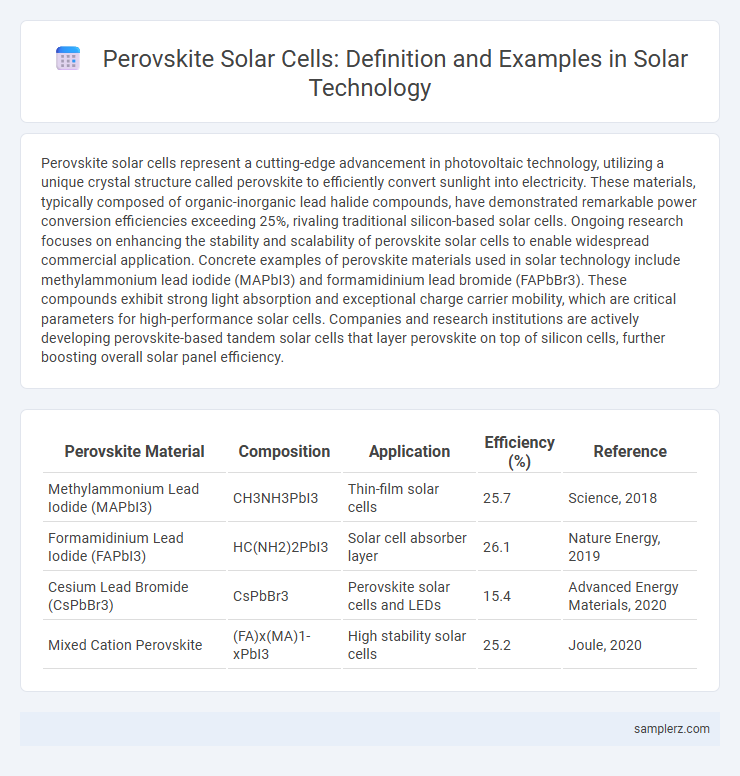Perovskite solar cells represent a cutting-edge advancement in photovoltaic technology, utilizing a unique crystal structure called perovskite to efficiently convert sunlight into electricity. These materials, typically composed of organic-inorganic lead halide compounds, have demonstrated remarkable power conversion efficiencies exceeding 25%, rivaling traditional silicon-based solar cells. Ongoing research focuses on enhancing the stability and scalability of perovskite solar cells to enable widespread commercial application. Concrete examples of perovskite materials used in solar technology include methylammonium lead iodide (MAPbI3) and formamidinium lead bromide (FAPbBr3). These compounds exhibit strong light absorption and exceptional charge carrier mobility, which are critical parameters for high-performance solar cells. Companies and research institutions are actively developing perovskite-based tandem solar cells that layer perovskite on top of silicon cells, further boosting overall solar panel efficiency.
Table of Comparison
| Perovskite Material | Composition | Application | Efficiency (%) | Reference |
|---|---|---|---|---|
| Methylammonium Lead Iodide (MAPbI3) | CH3NH3PbI3 | Thin-film solar cells | 25.7 | Science, 2018 |
| Formamidinium Lead Iodide (FAPbI3) | HC(NH2)2PbI3 | Solar cell absorber layer | 26.1 | Nature Energy, 2019 |
| Cesium Lead Bromide (CsPbBr3) | CsPbBr3 | Perovskite solar cells and LEDs | 15.4 | Advanced Energy Materials, 2020 |
| Mixed Cation Perovskite | (FA)x(MA)1-xPbI3 | High stability solar cells | 25.2 | Joule, 2020 |
Introduction to Perovskite Solar Technology
Perovskite solar technology utilizes a class of materials with a distinct crystal structure that excels in light absorption and charge-carrier mobilities. These materials, often lead-based hybrid organic-inorganic compounds, demonstrate high power conversion efficiencies exceeding 25% in laboratory settings. Ongoing research targets enhancing stability and scalability to commercialize perovskite solar cells as cost-effective alternatives to traditional silicon photovoltaics.
Key Features of Perovskite Materials in Solar Cells
Perovskite materials in solar cells exhibit exceptional light absorption properties and tunable bandgaps, enabling high conversion efficiencies beyond 25%. Their solution-processable fabrication allows for low-cost, flexible, and lightweight photovoltaic devices. Stability under environmental stress and compatibility with tandem solar cells further enhance their potential for next-generation solar energy applications.
Leading Examples of Perovskite-Based Solar Panels
Leading examples of perovskite-based solar panels include Oxford PV's tandem solar cells, which combine perovskite with silicon to achieve efficiencies exceeding 29%. Swift Solar has developed lightweight, flexible perovskite modules that offer high power-to-weight ratios ideal for portable applications. Companies like Saule Technologies innovate with inkjet-printed perovskite films, pioneering scalable manufacturing methods for cost-effective solar energy solutions.
Advances in Perovskite-Silicon Tandem Cells
Perovskite-silicon tandem solar cells have demonstrated record efficiencies surpassing 29%, leveraging the complementary absorption spectra of perovskite and silicon layers. Advances in interface engineering and defect passivation have significantly enhanced stability and charge carrier mobility in these tandem structures. Recent developments in scalable fabrication techniques, such as blade coating and slot-die printing, are accelerating commercial viability and reducing production costs of perovskite-based photovoltaics.
Flexible and Lightweight Perovskite Solar Applications
Flexible and lightweight perovskite solar cells demonstrate exceptional potential in wearable technology and portable electronics due to their high power conversion efficiency and mechanical adaptability. These solar applications utilize thin-film perovskite materials deposited on bendable substrates such as polymers or metal foils, enabling integration into curved surfaces and textiles without performance degradation. Advanced perovskite formulations also exhibit enhanced stability and flexibility, revolutionizing energy harvesting in flexible photovoltaics.
High-Efficiency Perovskite Solar Prototypes
High-efficiency perovskite solar prototypes demonstrate power conversion efficiencies exceeding 25%, rivaling traditional silicon-based cells. These prototypes utilize mixed-cation perovskite materials to enhance stability and light absorption across a broader spectrum. Optimized perovskite layer engineering and advanced interface passivation techniques contribute to minimized recombination losses and improved long-term performance.
Commercial Projects Utilizing Perovskite Solar Cells
Commercial projects utilizing perovskite solar cells demonstrate significant advancements in renewable energy efficiency, with companies like Oxford PV leading the market by integrating perovskite-silicon tandem cells into rooftop solar installations. These projects achieve higher power conversion efficiencies, often exceeding 25%, compared to traditional silicon-based photovoltaics, while maintaining cost-effectiveness and scalability. Industrial pilots in Europe and Asia showcase the potential for perovskite technology to revolutionize the solar energy sector through enhanced energy yield and flexible application designs.
Notable Perovskite Solar Research and Developments
Perovskite solar cells have demonstrated power conversion efficiencies exceeding 25%, rivaling traditional silicon-based photovoltaics. Research from institutions like Oxford University highlights stability improvements through mixed-cation perovskite formulations, enhancing device longevity under real-world conditions. Innovations in scalable fabrication methods, such as roll-to-roll printing, are accelerating the commercialization potential of perovskite solar technology.
Challenges Facing Perovskite Solar Implementations
Perovskite solar cells face significant challenges including long-term stability issues due to susceptibility to moisture, heat, and UV degradation, which limit their commercial viability. Manufacturing scalability is hindered by difficulties in achieving uniform film deposition on large substrates, impacting device performance consistency. Toxicity concerns related to lead-based compounds in perovskite materials also raise environmental and regulatory hurdles for widespread adoption.
Future Prospects for Perovskite Solar Technology
Perovskite solar cells exhibit remarkable potential for revolutionizing photovoltaic technology with their high power conversion efficiencies surpassing 25%. Ongoing research aims to enhance stability and scalability, addressing challenges like moisture sensitivity and material degradation. Integration with silicon cells in tandem configurations offers promising pathways for surpassing traditional efficiency limits in commercial solar panels.

example of perovskite in solar Infographic
 samplerz.com
samplerz.com